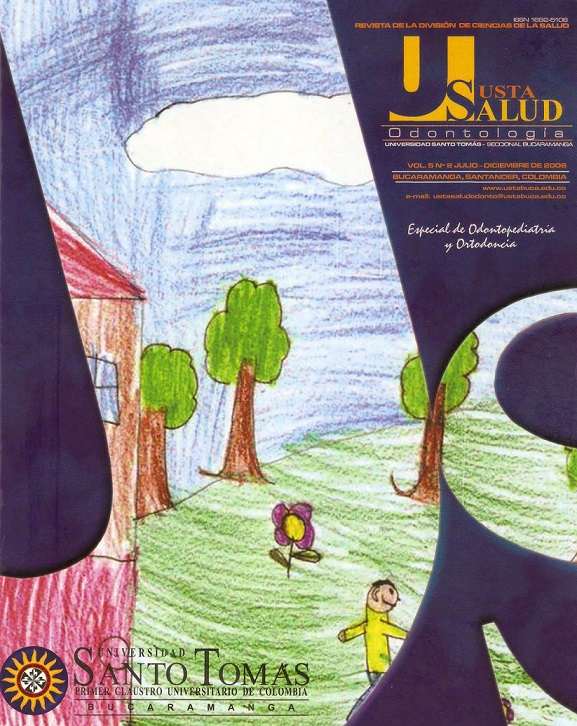MORFOLOGÍA CRANEOFAOAL EN PADRES DE NIÑOS CON LABIO Y PALADAR HENDIDO
Resumen
Objetivo: Identificar en los padres los medidos cefalométricas que pueden ser usados como predictores de lo posibilidad de tener hijos con labio y/o paladar hendido.
Materiales y Métodos: Mediante un estudio observacional descriptivo, se tomó por conveniencia una muestra de 83 padres y madres de hijos con hendiduras orofociales que asistieron a la Fundación Operación Sonrisa en Bogotá y Bucaramanga, y 23 padres y madres de hijos sin hendiduras orofociales que vivían en Bucaramanga. A cado uno se le tomó uno radiografía lateral en la que se tuvieran en cuenta 12 medidas lineales y angulares para el análisis. Se evaluó el nivel de reproducibilidad interevaluador mediante el análisis del acuerdo de Bland y Altman. Para comparar los medidas cefalométricas entre los grupos de estudio se aplicó prueba t de Student para comparar entre los dos grupos de estudio y ANOVA para comparar los promedios de medidas cefalométricas por tipo de hendidura, considerando un nivel de significancia de α=0.05.
Resultados: Los medidas cefalométricas que se encontraron diferentes entre los dos grupos de estudio fueron: Co - A, ENA - ENP, Go - Me, S - N, Ángulo SNB y todas estaban disminuidas de manera estadísticamente significativa (P < 0.05) en el grupo de madres cuyos hijos registraban labio y paladar fisurado. No se observaron diferencias estadísticamente significativas en las medidas de los padres.
Conclusión: Se podría sugerir una mayor injerencia genética materna en la morfología craneofacial.
[Cañón OL, Gutiérrez VE. Morfología craneofacial en padres de niños con labio y paladar hendido. Ustasalud Odontología 2006; 5: 85 - 92]
Referencias
2. Muñoz J, Bustos I, Quintero C, Giraldo A. Factores de riesgo para algunas anomalías congénitas en la población colombiana. Revista de Salud Pública 2003. URL disponible en: http://www.medicina.unal.edu.co
3. Ward R, Bixler D, Jamison P. Cephalometric evidence for a dominantly inherited predisposition to cleft lip - cleft palate in a single large kindred. Am J Med Genet 1994; 50: 57 - 63.
4. Scapoli L, Martinelli M, Pezzetti F, Carinci F, Bodo M, Tognon M, Carinci P. Linkage disequilibrium between GABREB3 gene and nonsyndromic familial cleft lip with or without cleft palate. Hum Genet 2002; 110: 15 - 20.
5. Thorogood P, Ferreti P. Heads and tales: recente advances in craniofacial development. Br Dent J 1992; 173: 301 - 306.
6. Wyszynski DF, Beaty TH. Review of the role of potential teratogens in the origin of human nonsyndromic oral cleft. Teratology 1996; 53: 309 - 317.
7. Bianchi F, Calzolari E, Ciulli L, Cordier S, Gualandi F, Pierini A, Mossey P. Environment and genetics in the etiology of cleft lip and cleft palate with reference to the role of folic acid. Epidemial Prev 2000; 24: 21 - 27.
8. Mossey PA, McColl JH, Stirrups DR. Differentiation between cleft lip with or without cleft palate and isolated cleft palate using parental cephalometric parameters. Cleft Palate Craniofac J 1997; 34: 27 - 35.
9. Coccaro PJ, D’Amico R, Chavoor A. Craniofacial morphology of parents with and without lip and palate children. Cleft Palate J 1972; 9: 28 - 42.
10. Nakasima A, Ichinose M. Characteristics of craniofacial structures on parents of children with cleft lip and/or palate. Am J Orthod 1983; 84: 140 - 146.
11. Prochazkova J, Vinsova J. Craniofacial morphology as a marker of predisposition to isolated cleft palate. J Craniofac Genet Dev Biol 1995; 15: 162 - 168.
12. Peters H, Neubuser A, Kratochwil K, Balling R. Pax 9 deficient mice lack pharyngeal pouch derivatives and teeth and exhibit craniofacial and limb abnormalities. Gene Dev 1998; 12: 2735 - 2747.
13. McIntire GT, Mossey PA. The craniofacial morphology of the parents of children with orofacial clefting: a systematic review of cephalometric studies. J Orthod 2002; 29: 23 - 29.
14. McIntire GT, Mossey PA. Asymmetry of the parental craniofacial skeleton in orofacial clefting. J Orthod 2002; 29: 299 - 305.
15. Bland M, Altman D. Statistical methods for assessing agreement between two methods of clinical measurements. Lancet 1986; 8: 307 - 310.
16. Pagano M, Gauvreau K. Principies of biostatistics. Duxbury Press, Belmont Ca, 1993.
17. Ward RE, Buxer D, Raywood ER. A study of cephalometric features in cleft lip-cleft palate families. I: Phenotypic heterogeneity and genetic predisposition in parents of sporadic cases. Cleft Palate J 1989; 26: 318 - 325.
18. Prochazkva J, Tolarova M. Craniofacial morphological features in parents of children with isolated cleft palate. Acta Chir Plast 1986; 28: 194 - 204.
19. Blanco R, Cifuentes L, Maldonado MJ, Rameau MX, Muñoz MA. Cleft lip and cleft palate, cephalometric features of affected individuals, their relatives and a control population. Rev Med Chile 1992; 120: 13 - 19.
20. Nakasimo A, Ichinose M. Size in cranium in parents and their children with cleft lip. Cleft Palate J 1984; 21: 193- 203.
21. Raghavan R, Sidhu SS, Kharbanda OP. Craniofacial pattern of parents of children having cleft lip and/or cleft palate anomaly. Angle Orthod 1994; 64: 137 - 144.
22. Mossey PA, McColl J, O'Hara M. Cephalometric features in the parents of children with orofacial clefting. Br J Oral Maxillofacial Surg 1998; 36: 202 - 212.
23. Sato T. Craniofacial morphology of parents with cleft lip and palate children. Shikwa Gakuho 1989; 89: 1479 - 1506















